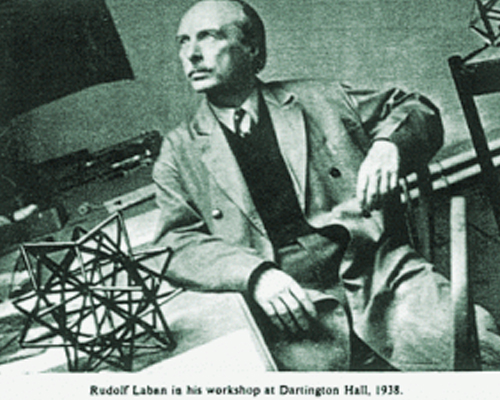Laban began his career as a painter, architect and illustrator. His life-long involvement in movement and dance began in Munich in 1910 when he was commissioned to choreograph mass events for the Bavarian carnivals. Research and practice into the creation of a new dance form , together with the publication of his book, ‘Die Welt des Tanzers’ in 1920, brought him public acclaim and facilitated his career as choreographer of his own touring company ‘TanzbuhneLaban’. By 1930 his work and inspiration at both the professional and community levels, had spawned a host of Laban Schools across Central Europe and raised his profile as the foremost figure in the evolution and development of European Modern Dance.
Laban arrived in England in 1938 as a refugee from Nazi Germany. He had taught and inspired Mary Wigman and Kurt Jooss. He had choreographed at Bayreuth and directed at the Berlin Opera. His invention of the ‘Movement Choir’, embodying the inclusive notion of ‘dance for all’, anticipated the current growth of the Community Dance Movement by 60 years.
Today, his ideas have generated innovations in dance, acting, performance, the study of non-verbal communication, in ergonomics, industry and management, personality assessment and psychotherapy. He was the founding father of Dance Education in the British Education System and his invention of ‘Schrifftanz’, a notation system for dance is used as a recording system worldwide.
Rudolf Laban found a fascination in observing people’s movements in all aspects of life. His analysis of movement is based on anatomical, spatial and dynamic principles. He charted the multiple forms and functions of the body in action; its patterns of movement in the surrounding space and the expressive qualities of movement that affect communication and individual characterisation.
The analysis is flexible, providing a means of observing, understanding and describing movement – both quantitatively and qualitatively – which can be applied to all forms of movement and areas of body movement research. Colleges and universities in the UK, Australia, Europe, South Africa, the USA, Canada and South America have courses of study in areas of Laban’s work, with graduates who are teaching, choreographing, performing, practising therapy, notating, writing about dance and developing research.
Laban’s work is profound, charged with seminal ideas and open to development. His legacy constitutes an invaluable contribution to the world of dance and to culture.

Anna Carlisle
References:
Rudolf Laban: An Extraordinary Life by Valerie Preston-Dunlop – published by Dance Books 1998
Staying Alive article by Anna Carlisle – originally published in Animated and reprinted in Movement & Dance Autumn 2006
Photo from Gordon Curl’s collection
